No-knead bread is extra crispy on the outside and bubbly on the inside. With very little effort, you’ll get an amazing outcome each and every time.

No-knead bread is a staple that we make on a weekly basis. Whether we pair it with soups or make fresh sandwiches with it, we find it so easy to make that we rarely buy packed bread anymore.
Dutch Oven No-Knead Bread has been highly requested by so many of you. So here we are, answering your call!
The difference between knead bread and no-knead bread is pretty straightforward — one requires you to do the kneading and the other doesn’t. There has been much debate about whether or not bread can be made by skipping this essential step. But, through the powers of the dutch oven, it’s hard to argue that it can’t be done! It works every single time!
How to Make No-Knead Bread
- Mix the dry ingredients together and add water. Stir until you form a sticky ball.
- Cover and let it set for 24 to 48 hours.
- Flour your hands and press down on the dough ball. Reform the dough into a ball shape. Let it rise on a parchment paper.
- Preheat your dutch oven. Move the bread dough with parchment paper inside.
- Bake in a dutch oven covered for the first 30 minutes and for 15 minutes without a lid.
- Remove the bread from the dutch oven and let it cool on a wire rack. Serve and enjoy!






If you are looking for a great Dutch oven, I have some favorites. I use my Staub dutch oven most. Le Creuset great option too.
Dutch Oven Alternatives
If you don’t have a dutch oven, use our other no-knead bread recipe. This is the method that I used for over 10 years and it works amazingly.
Basically you need two baking sheets, one with bread on it and a second one with water. On a bottom rack, you place water, it creates a steam bath for the bread to rise on a middle rack. The result is very similar and just as good!
No Knead Bread Rising
No-Knead Bread needs 12-48 hours to rise. This slow rising method allows the bread to create the extra airy bubbles in the bread. After shaping the dough into a loaf, you want to give the dough 30 to 60 minutes of rising time.
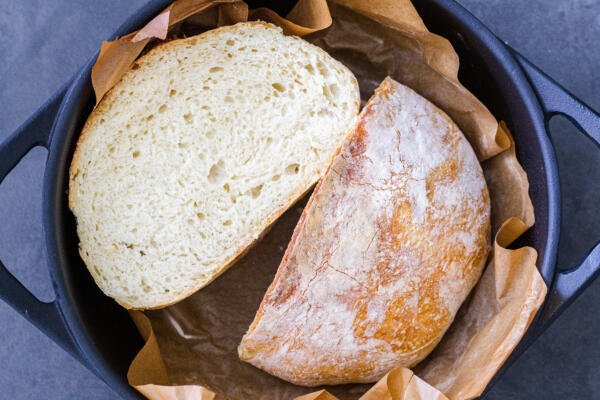
Troubleshooting – Bread Too Dense
There are several different reasons why your bread came out dense. Here’s a couple pitfalls and how to avoid them:
- Adding too much flour. This recipe calls for strict measurements when baking.
- Using improper flour. Try using flour with higher protein content to get the best texture. A couple of my favorites include King Arthur or Bobs’ Red Mill. Any Canadian brand will typically fit the bill.
- Using old yeast. This common mistake happens to the best of us. Over time, active yeast deactivates and loses its ability to make your bread rise and fluff.
- Ending the fermenting process too early. No-knead bread saves you from a lot of arm work, but it still requires a good chunk of time to set. Ending the fermenting process too early will likely cause you to get dense bread. 12 hours or more is the sweet spot for a light and fluffy texture.
- Not allowing the bread to rise in a warm place. After you form your loaves, it is essential that you let your bread rise in a warm place.
Other No-Knead Treats
- No-Knead Easy Cinnamon Rolls – Easy cinnamon rolls are made with no-need-to-knead dough. They are ultra-fluffy and perfectly sweet.
- No-Knead Buns – These are incredible and so perfect for your next burger party.
- No-Knead Baguette – Crunchy, chewy and so good for your new cheese platter.
Recipe
Instructions
- Combine the dry ingredients together.
- Add in the wet ingredients and stir to combine everything together until the dry ingredients are no longer visible.
- Cover the dough using a plastic wrap and allow for the dough to sit for at least 12 hours at room temperature.
- Flour a working surface and shape the dough into a bread shape. Sprinkle the parchment paper with flour and place the dough on it. Cover it using a towel and allow it to rise for about 30-60 minutes.
- Preheat the oven to 425 °F, with the dutch oven inside. Place the bread dough inside of the dutch oven together with parchment paper. Bake it for 30 minutes with the lid on.
- Remove the lid and bake the bread for another 15 minutes. Leave the bread on a wire rack to cool down before cutting into it.

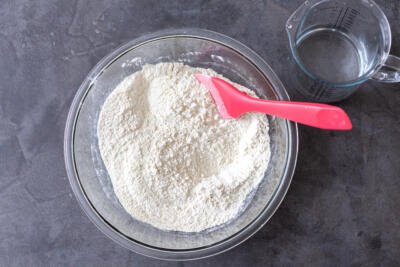
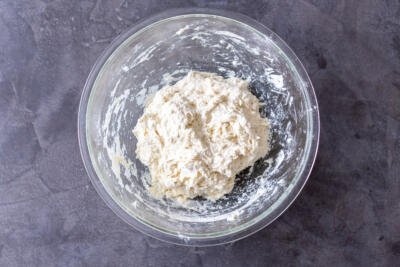
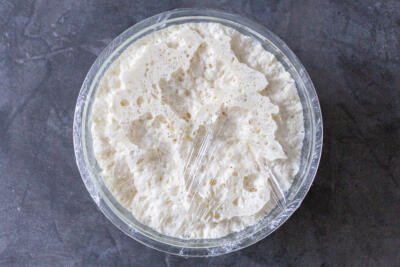


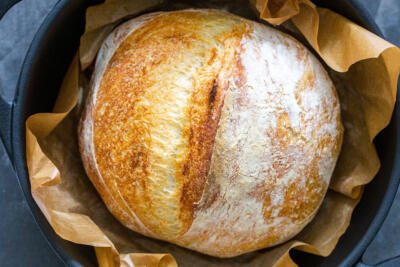


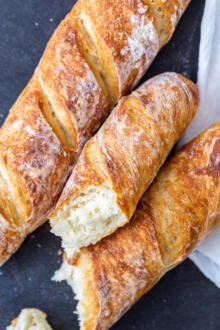
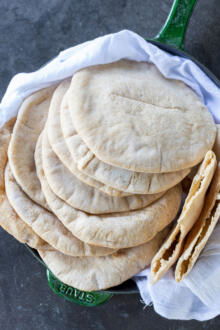
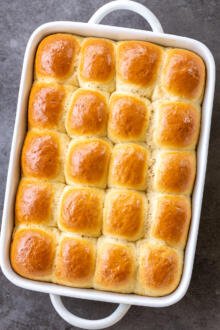
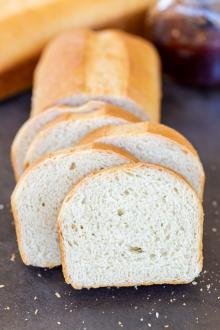
Hi Natalya - we fans of yours in Europe find the cup vs grams thing is very confusing. PLUS in your video, you seem to wing it, one cup looked heaped, another not really full. I used your metric conversion and was happy it equaled 125g to 1 cup (that's what we use here) and I used the flour you recommended too but the dough seems wet-ish. I read your response to "Paul" below and you advised him to just goes with the cup - then why have a metric conversion if it's not accurate? The bread is in the oven. I'm hoping this works out!
Hi dear, this recipe is very forgiving and you can use cups for the measurements but grams are accurate too. The dough will be "wet-ish" but thats totally normal. This is what makes the bread very bubbly. You can see the texture of the dough in my step 3 photo. I hope this was helpful. Let me know if you have any other questions. Thanks
I would love to make this bread but I do not have a dutch oven and I was told that I could use a pizza stone. Is this true and does it work.
Hey Cathy, Here is a recipe that can work really well with no dutch oven, I think it will help you better in the process. https://momsdish.com/recipe/1…
Love this recipe. I don’t believe I’ve seen this questioned posted before…am I ok to preheat and bake two dutch ovens at the same time? If so, I normally place one dutch oven at medium level oven rack. Is that still good or should I consider lowering down one rack level for two baking at the same time. Thank you so much.
Hi Frank- I think that should work! If you can fit both of the dutch ovens on the same middle rack, then it shouldn't be a problem.
I have made this bread at least - 25 - 30 times and love all the compliments. I gave 3 granddaughters Dutch Ovens for Christmas and your wonderful recipe. They love thier Bebe even more. By the way, love all of your recipes. You make life a little easier and fun. Thanks again Natalya. Happy New Year.
Wow, thank you so much for your kind words! It means the world to me that my recipe has become such a special part of your life—and your granddaughters’ too! What a thoughtful gift; I’m sure they’ll treasure those Dutch ovens and all the memories you’ve shared. ❤️ Wishing you and your family a Happy New Year filled with even more delicious moments! 🥳
My dough has been resting for 12 hours. I'm ready to let it rise and it is a blob of wet dough. I have been trying to add flour so I can form into round mound and it is a blob. Help.
Hey, what type of flour did you use, brand? You can see how I shape sourdough here https://www.youtube.com/watch…, it may help with shaping. Often getting your hands wet helps with working with dough. But I wonder what flour you used because that can make a difference.
What size Dutch oven? Thanks.
Hi Diane, typically I use 5 qt. I also have a 7qt that I use sometimes. Hope this helps, happy baking!
I have made this recipe atleast 20 x. Ita soooo good. Ita gets devoured everytime. Such a good recipe. I also add a 1.5 tsp of sugar too thebdry ingredients and it turnd out so good. My boys like it more then the sourdough. Easier for me 🙂
I'm thrilled that this bread is on repeat in your home Marina. Thanks for sharing how much your boys love it!
Success on the first try! Thank you.
Hi Virginia, Yay! So glad to hear that!
Hi Natalya, I’ve been trying different bread recipes. Thx recipe was a challenge. Like Peggy, my dough was like a blob, sort of expected that during the first mixing. So after the first rise, I had to a bit of flour while folding the dough until I can make a ball, then put it in a riser for an hour before baking in the Dutch oven. It came out good, looking like a beehive. Thanks for the challenge.
Manny
Hi Manny, thanks so much for sharing your experience! 😊 It sounds like you handled the challenge like a pro—sometimes working with sticky dough can feel like taming a blob, but it’s all worth it in the end!
When reading "how to make this bread", it says to let rise for 24 to 48 hours. When scrolling down to the "directions" listed under the measured ingredients, it says 12 hours. Which is it? I'm new to making bread and I don't know if it would make a difference. Thanks.
Hi Lynne, Let it rise for at least 24 hours - and thank you for pointing that out. We will work on fixing that typo. 🙂
Natalya,
I am wanting to try this bread but here is my problem. If I use a scale to weigh the amount of bread it doesn't measure up when I then put it in a 3 cup measuring cup. It is quite a bit short. I take my scale, zero it out after I put my measuring cup on it, then add my flour to the measuring cup. If I fill the measuring cup to the full mark it shows 139 grams of flour for each cup. I don't want to waste 3 cups of bread flour if it is wrong. Any suggestions?
Paul, it will depend if you are using US cups or Imperial cups.
US cups are smaller than Imperial cups.
Hi Paul, it might the way the conversion calculator converts it. The US measurement is based on volume, while the metric system is based on weight. If you have an option, use cups because it makes it more accurate in this recipe. Hope this helps.
Good morning 😃 I’m trying your recipe for the first time. Getting ready to bake in about an hour
I sure hope it turns out as beautiful as yours 🤗
Thank you
Hi Maria, I am sure it is going to be perfect! Let me know how you like it when it comes out. Enjoy!!
It says to let the dough sit at least 12hr... what would be the maximum amount of time to let sit before baking?
Hi Mary, You can let it sit up to 24 hours. Thanks for reaching out. Good luck!
When I let the bread cool on a rack ,do I take out of the pan?
Hi there, Jean! I recommend that you take it out of the pan. Thank you for the question, Enjoy!
Can I make these into rolls or hoagies??
Hey Debbie, absolutely. I think you may need to adjust baking time based on their size. Hope this helps.
Hello,
Followed this recipe and baked this morning. It turned out amazing.
Sooo good.
I did use sourdough starter instead of the yeast called for.
Works for me
Thanks
Rosa
How much sourdough starter did you use in place of the yeast?
Hi Rosa, So glad you were able to make this recipe your own! Thank you for sharing. Enjoy!
Enjoy the recipe but would like to add cheese, spices maybe olives can this be done with this recipe and how much?
Hey Winnie, I have not tested the recipe with any add-ins. If you try it, would you let me know how it goes?
what is the smallest size dutch oven you can use for your bread?
Hi Carol- I'd say probably 5 quarts. Enjoy!
Hi, can i mix cheese and walnut into the dough?
Hey there- this is a great question- I haven't tested the recipe with any add-ins! If you give it a try, let us know how it turned out!
Hi! How can you store the leftover bread?
Hey Dee- a bread box, plastic wrap, or ziplock bag would work great.
Hello, how big is the cup?I have different sizes cups at home. Can you write the flour in grams please?an water as well?
Hey Aneta- One cup of flour is roughly 120 grams, while a cup of water is 240 grams. However, we do have a metric option for our recipes and it's found in the recipe card- just switch over to the metric option. Enjoy!
Hola !! Las 12 horas de reposo, es en nevera ? Y , la harina ultilizada es todo uso? Podría usar bread Flour?
Hello!! The 12 hours of rest, is it in the fridge?
And, is the flour used all-purpose? Could you use bread Flour?
Hi Fanny- the 12 hours of rest is at room temp/on the counter. I do recommend using bread flour since it has a higher protein count. Enjoy!
I live in a super hot country in the tropics, hence the question of letting it rise at room temperature or in the fridge
Hey Fanny- I wish I had more tips but I don't have experience making this bread in super warm/tropical climates. My kitchen doesn't get overly hot so I can't say if you would need to adjust the rising or resting time.
I did it! I stay great. As I told you, I left it for an hour at room temperature and then I put it in the fridge until it was 12 hours old. I don't know how I can send you a photo.
Gracias!
I'm so glad to hear that, Fanny! If you have Facebook or Instagram you can try tagging us in a photo there. 🙂
I'm going to do it and then I'll tell you!
Is dry active yeast the same as dry yeast? I’m a rookie. 🤭
Hi Rosie- yes, that is correct! There are the 2 types of yeast: active dry yeast or instant yeast, and they are generally pretty interchangeable for most recipes.
P.S. rookies are always welcome here, we try to make our recipes as easy as possible! Enjoy 😀
Can you use whole wheat flour?
Hi! I have made it with 2 cups bread flour and 1 cup whole wheat. Or you could also just do half and half.
Works great!
Hi, I just made today with Arthur’s white whole wheat flour. It was a little dense. Any suggestions? I also noticed that after the 30-60 min of resting the sought stayed around the same size as it was before.
Hey Candace- I haven't tried with whole wheat for this recipe so I don't have exact answers. Maybe 1/2 whole wheat and half regular flour would help with density?
Hi Nancy- I have only tested this recipe with regular flour. If you end up using whole wheat, let us know how it goes!
Hi can I use a Visions casserole instead of Dutch oven to make the bread?
Hello Maz- I haven't tried using a visions casserole before so I'm not sure what the outcome would be like!
Hello! What brand of Canadian flour do you use?
Hey Stephanie, when we lived in Seattle, we would drive down to Canada very often. I would get some at Costco. But if you want a very similar outcome, use Bobs Redmill flour, it's amazing.
What size of Dutch oven?
Hi Carol, mine is 5QT. It works well for this recipe.
Can you use almond flour to make a low carb version?
Hi Ron, I have never tested this recipe with almond flour. Unfortunately, I dont think the outcome would be the same.
Thanks I love it so yummy
Happy to hear this! 🙂 Thanks for sharing.
Can you bake this in a cast iron Dutch oven ? If do same oven trmp ?
Hey Pat, yes, you would use the same temperature. Enjoy it.
Hi! Once you form the ball and place it on parchment paper to rise, how long do you let it rise for?
Hey Brigid, usually up to an hour, it depends on the temperature in your home. But 30-60 minutes is plenty. Enjoy